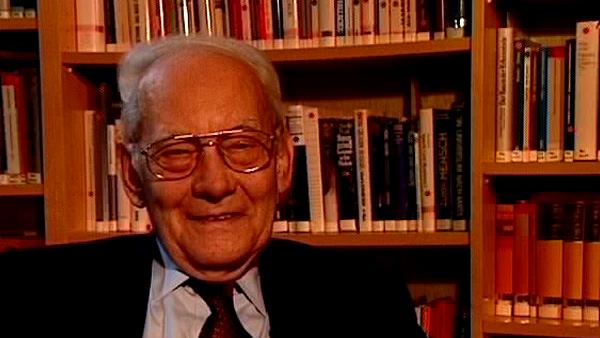NEXT STORY

Getting pretty arrogant during my studies
RELATED STORIES

NEXT STORY

Getting pretty arrogant during my studies
RELATED STORIES


|
Views | Duration | |
|---|---|---|---|
| 1. Early childhood recollections about music | 1725 | 02:49 | |
| 2. My father's conditions when I wanted to give up the piano | 460 | 05:34 | |
| 3. My parents did not agree with my teachers' view of the Nazis | 574 | 03:56 | |
| 4. Being drafted at fifteen | 535 | 03:48 | |
| 5. Walking home at the end of the war | 369 | 02:05 | |
| 6. Choosing between music and science | 433 | 01:06 | |
| 7. Going to university and building a seismograph | 334 | 04:11 | |
| 8. Göttingen University and some of its famous professors | 461 | 03:29 | |
| 9. My thesis: 'The specific heat of heavy water' | 412 | 02:50 | |
| 10. Building an adiabatic calorimeter | 304 | 03:21 |

What I had to do was to build a calorimeter. A calorimeter to measure specific heats. You know the specific heat tells you how much energy you have to put into the material to increase the temperature by 1°C. And that amount of heat tells you where the energy is going, it goes into the vibrations, it goes into the rotation and the translation of the molecule, so the specific heat is an indicator of the energy states of the molecule which they can assume. Of course, it also gives a contribution to the interaction among the molecules, especially to the hydrogen bonding, so when you heat up water you break some of the hydrogen bonds and there is a bond energy involved, and so that shows up in the specific heat. That's why Eucken wanted to have measurements of specific heat, and I had to build a calorimeter, which is a very precise instrument. To give you an impression of that, it's a so-called adiabatic calorimeter, which means that the whole vessel containing the heavy water is surrounded by a mantle, and then there is a differential thermocouple which measures the temperature between the inside and the outside, and you regulate the heat at the mantle such that there is no temperature difference between inside and outside, so heat loss cannot occur. That's the adiabatic calorimeter. And to give you an impression, the thermocouple measures a temperature precise by one thousandth of a degree, and the whole measurement went over about 100°C, so hundred and a thousandth, that gives you the five decimals which we needed for the measurement.
Well, I built such an instrument and started my...
[Q] You mean the glass shop built this sophisticated instrument?
Oh yes, the glass shop and the mechanic machine shop...
[Q] According to your [design]...
The other thing, there'd be the heating which is electric and so on, precise measurements of course, you have to measure very carefully the voltage and the current and so on. But the big question which appeared was, to what temperature can we go? Eucken, of course, wanted to go as high as possible with the temperature, and since the water was melted into the glass vessel, the question is: what pressure does a glass vessel withstand?
Nobel Prize winning German biophysical chemist, Manfred Eigen (1927-2019), was best known for his work on fast chemical reactions and his development of ways to accurately measure these reactions down to the nearest billionth of a second. He published over 100 papers with topics ranging from hydrogen bridges of nucleic acids to the storage of information in the central nervous system.
Title: Building an adiabatic calorimeter
Listeners: Ruthild Winkler-Oswatitch
Ruthild Winkler-Oswatitsch is the eldest daughter of the Austrian physicist Klaus Osatitsch, an internationally renowned expert in gas dynamics, and his wife Hedwig Oswatitsch-Klabinus. She was born in the German university town of Göttingen where her father worked at the Kaiser Wilhelm Institute of Aerodynamics under Ludwig Prandtl. After World War II she was educated in Stockholm, Sweden, where her father was then a research scientist and lecturer at the Royal Institute of Technology.
In 1961 Ruthild Winkler-Oswatitsch enrolled in Chemistry at the Technical University of Vienna where she received her PhD in 1969 with a dissertation on "Fast complex reactions of alkali ions with biological membrane carriers". The experimental work for her thesis was carried out at the Max Planck Institute for Physical Chemistry in Göttingen under Manfred Eigen.
From 1971 to the present Ruthild Winkler-Oswatitsch has been working as a research scientist at the Max Planck Institute in Göttingen in the Department of Chemical Kinetics which is headed by Manfred Eigen. Her interest was first focused on an application of relaxation techniques to the study of fast biological reactions. Thereafter, she engaged in theoretical studies on molecular evolution and developed game models for representing the underlying chemical proceses. Together with Manfred Eigen she wrote the widely noted book, "Laws of the Game" (Alfred A. Knopf Inc. 1981 and Princeton University Press, 1993). Her more recent studies were concerned with comparative sequence analysis of nucleic acids in order to find out the age of the genetic code and the time course of the early evolution of life. For the last decade she has been successfully establishing industrial applications in the field of evolutionary biotechnology.
Tags: Calorimeter, specific heat, hydrogen bonding, adiabatic calorimeter, thermocouple, heavy water, Arnold Eucken
Duration: 3 minutes, 22 seconds
Date story recorded: July 1997
Date story went live: 24 January 2008